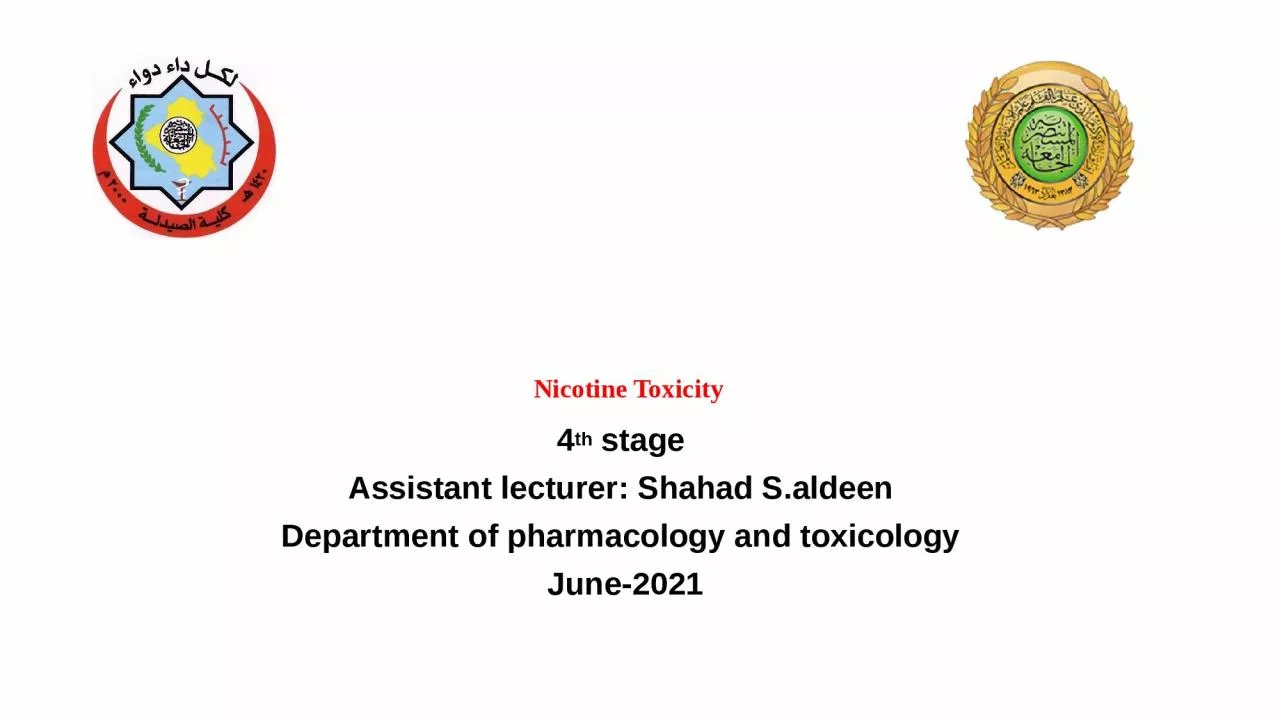

Assistant lecturer Shahad Saldeen Department of pharmacology and toxicology June2021 Introduction Nicotine is a toxic substance found in the tobacco plant Nicotiana tabacum The commercial preparation of the plant involves drying the leaves for the production of chewing tobacco ID: 1009869
Download Presentation The PPT/PDF document "Nicotine Toxicity 4 th stage" is the property of its rightful owner. Permission is granted to download and print the materials on this web site for personal, non-commercial use only, and to display it on your personal computer provided you do not modify the materials and that you retain all copyright notices contained in the materials. By downloading content from our website, you accept the terms of this agreement.
1. Nicotine Toxicity4th stage Assistant lecturer: Shahad S.aldeen Department of pharmacology and toxicology June-2021
2. IntroductionNicotine is a toxic substance found in the tobacco plant (Nicotiana tabacum). The commercial preparation of the plant involves drying the leaves for the production of chewing tobacco, cigars, cigarettes, & snuff. Nicotine is easily isolated from the plant for use in nicotine replacement products (gum, patches, & nasal spray)
3. Therapeutic uses of nicotinePrimary TU of nicotine is in treating nicotine dependence in order to eliminate smoking. Example : “NICORETTE GUM” used to treat nicotine addiction .
4. Smoke tobacco Snuff
5. Routes of exposure
6. Green Tobacco Sickness (GTS)A set of symptoms caused by nicotine poisoning, often due to exposure during tobacco harvesting.Management If the skin exposed to wet tobacco leaves, conc. nicotine liquid, or nicotine pesticide , patient's clothing promptly removed & the skin thoroughly washed with soap & water.
7. Absorption of nicotine Nicotine has pKa value of 7.9, its well absorbed through the buccal mucosa, respiratory tract, intestinal tract, and skin.Absorption of nicotine across biological membranes depends on pH (hyperacidity reduce absorption since it become in ionized form which is less absorbable).
8. Distribution of nicotineNicotine generally achieves a volume of distribution of 1 L/kg. reaches the brain in approximately 8 seconds, with CNS levels of nicotine rising rapidly & then declining rapidly as the drug is redistributed to other tissues. Nicotine readily cross the placenta & also transmitted in small concentrations in breast milk.
9. Metabolism of nicotineMetabolism takes place primarily in CYP450 system of the liver (80-90%), but also, to lesser extent, in the kidney & lung.Nicotine t1/2 is 1-4 hr & the main oxidative metabolites of nicotine are: 1- Cotinine (major) 2- Nicotine–1-N-oxide (minor)
10. Execration of nicotinePrimarily in urineIn Breast milk (in heavy smoker about 0.5 mg/L of milk), & this is large dose since infant is small.
11.
12. Mechanism of toxicityIn adrenal medulla:By binding to nicotinic receptors in the adrenal medulla nicotine increases flow of (epinephrine), a stimulating hormone & neurotransmitter. At nicotine binds to the receptors, it causes cell depolarization & influx of Ca through voltage-gated Ca+ channels. Calcium triggers the exocytosis of chromaffin granules & thus the release of epinephrine (& NE) into bloodstream. The release of epinephrine (adrenaline) causes an increase in heart rate, blood pressure & respiration, as well as higher blood glucose levels.
13. In CNS: By binding to nicotinic Ach receptors, nicotine increases the levels of several NT, It is thought that increased levels of dopamine in the brain which responsible for the euphoria & relaxation and eventual addiction caused by nicotine consumption. Nicotine has higher affinity for Ach receptors in brain than those in skeletal muscle, though at toxic doses it can induce contractions & respiratory paralysis.
14. Acute nicotine toxicityAcute nicotine exposure occurs from insecticide sprays or tobacco ,it associated with nausea, vomiting, salivation, diarrhea, dizziness, mental confusion, weakness Acute nicotine toxicity characterized by The biphasic pattern, started as initial stimulation ( ↑ H.R., ↑ B.P., ↑ R.R, hyperactivity) followed quickly by inhibition ( ↓H.R., ↓ B.P., ↓ R.R, hypoactivity) & if the death occur, attributed to respiratory paralysis.
15. Cont.Fatal exposure (60 mg fatal for adult) Decreased blood pressure Difficult breathing Irregular pulse Convulsions Respiratory failure & death.
16. ManagementOrogastric lavage if pt with oral exposureActivated charcoal effectively binds nicotine & should be used to absorption. Symptomatic treatment : Seizures benzodiazepines. Cardiovascular compromise atropine for symptomatic bradycardia fluids for hypotension. dopamine or nor epinephrine If hypotension does not respond to fluids. Respiratory compromise oxygen
17. Note: there is no specific antidote, only for animals we can use mecamylamine, hexamethonium & pimpedine.
18. Not recommended managementInduction of emesis not recommended because nicotine poisoning may cause unexpected seizures or respiratory depression.Urine acidification for enhancing elimination un necessary since it may cause complications of metabolic acidosis.
19. Procedure for nicotine toxicity5 cigarettes macerated in 50 ml hot D.W. overnight then filtered by filter paper.5 mice given 15, 18, 20, 22, 25 units IP. respectively of nicotine solution.Observe the biphasic pattern of nicotine toxicity that started as stimulation followed by depression then death if it occur.LD50% of nicotine for mice is 3 mg/kg